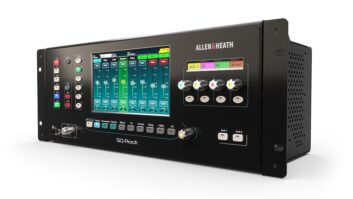When everybody in the audio biz goes one way, CAD always comes up
with something different. This time, that something is the M9, a cardioid tube mic combining a 1.1-inch diaphragm
capsule with the servo-valve technology used in its flagship VX2. The
front end is driven by a single 12AX7, followed by a high-speed,
low-noise, dual op amp that drives long cable runs with ease.
From the M9’s impeccable fit, finish and feel, you’d never know you
were dealing with a product retailing at $599 including aluminum flight
case, power supply, 30-foot 7-conductor cable, and shockmount. The
latter’s die-cast construction and sturdy elastics are light years
ahead of the usual “free shockmount” that accompanies most
other under-$1,000 mics, and the unit is great at isolating the mic
from external vibrations.
This side-address design has recessed switches for its -16dB (non-capacitive) pad and a subtle, quite gentle
(-6dB/octave @ 100 Hz) bass roll-off filter. The power supply is simple, with
AC switch (selectable for 120- or 240VAC use), removable power cord,
7-pin XLR input and standard 3-conductor XLR output (pin
2 hot).
The M9 is plug-and-go, although on power up, I was greeted by a
cacophony of pops and hiss until the tube stabilized about a minute
later. Then the noise disappeared completely, leaving just the sweet
sound of this mic. I started with a tracking date on a Taylor acoustic
guitar, with the mic about a foot from the soundhole. The result was
well balanced and bright, capturing the entire top end with tons of
warm bottom and detail. I had similar results cutting solos on my Gold
Tone Banjitar (6-string banjo). Normally, large-diaphragm tube mics
aren’t my first choice on close-in stringed instruments, but the M9
really surprised me here with well-formed transients and lots of zing.
Owwweee!
Next up, for overdubbing female R&B vocals the M9 really shined,
with its extended top end adding a smooth breathiness to the track and
a warm—but not overdone—proximity effect up close. The tightness of the
M9’s cardioid pattern is great for isolating the mic from other sounds,
but requires the vocalist to stay on-axis with the mic. This, however,
was only a problem when close-miking singers moved around a lot. The M9
was equally nice on male vocals, where its slight presence bump around
5 kHz helps bring baritones and bass singers out in a mix, while
providing a smooth balance of lows and highs.
The M9 performs like it costs a lot more, and its clean, flexible
performance fits in well, either as a first “good” mic for
the novice or as a new flavor in a well-stocked mic collection.
CAD Professional Microphones, www.cadmics.com







